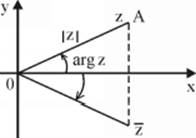University Mathematics Handbook (2015)
X. Algebra
Chapter 1. Complex Numbers
1.1 Definition: Algebraic Operations in Complex Numbers
a. An ordered pair of real numbers ![]() is called a complex number.
is called a complex number.
b. ![]() , when
, when ![]() , is the algebraic form of a complex number.
, is the algebraic form of a complex number.
![]() is called the real part of
is called the real part of ![]() , and is denoted
, and is denoted ![]() .
.
![]() is called the imaginary part of
is called the imaginary part of ![]() , and is denoted
, and is denoted ![]() .
.
c. ![]() is a conjugate to the number
is a conjugate to the number ![]()
d. Let ![]() and
and ![]() be two complex numbers:
be two complex numbers:
1. Equality: ![]() if and only if
if and only if ![]() and
and ![]()
2. Addition: ![]()
3. Multiplication: ![]()
4. Powers of ![]() :
: ![]() ,
, ![]() ,
, ![]()
5. Division: ![]()
6. ![]()
1.2 Geometric Description, Modulus and Argument
a. Any complex number ![]() can be described as point in plane
can be described as point in plane ![]() or a vector beginning in the origin and ending at point
or a vector beginning in the origin and ending at point ![]() .
.
Plane ![]() is called complex plane, when
is called complex plane, when ![]() -axis is Real Axis and
-axis is Real Axis and ![]() -axis is Imaginary Axis.
-axis is Imaginary Axis.

b. In the complex plane, ![]() is described by a vector symmetrical to
is described by a vector symmetrical to ![]() about
about ![]() -axis.
-axis.
c. The length of vector ![]() s called the modulus or absolute value of complex number
s called the modulus or absolute value of complex number ![]() and is denoted
and is denoted ![]() .
.
d. Angle ![]() between the vector corresponding to complex number
between the vector corresponding to complex number ![]() and the positive direction of the real axis is called the argument of
and the positive direction of the real axis is called the argument of ![]() and is denoted as
and is denoted as ![]() . It is measured counterclockwise, in radians.
. It is measured counterclockwise, in radians.
Notice: For every complex number, the modulus is specified definitely, but an argument has countless values different from each other by an integer product of ![]() .
.
e. ![]() is the polar form of a complex number. To have its polar form, we should just take an argument value of
is the polar form of a complex number. To have its polar form, we should just take an argument value of ![]() , or, alternately,
, or, alternately, ![]() , since an addition of
, since an addition of ![]() for
for ![]() does not change the values of
does not change the values of ![]() and
and ![]() .
.
f. The relation between the algebraic form ![]() and the polar form
and the polar form ![]() of a complex number is:
of a complex number is:
![]()
![]()
g. Properties of absolute value (modulus)
![]()
![]()
h. Properties of the argument
![]()
![]()
![]()
1.3 Powers and Roots of ![]()
a. De Moivre’s Formula: For every natural ![]() ,
,
![]()
b. The ![]() -th root of a complex number
-th root of a complex number ![]() is a complex number
is a complex number ![]() holding
holding ![]() . It is denoted
. It is denoted ![]() .
.
c. For every complex number ![]() ,
, ![]() there exist just
there exist just ![]() different complex numbers
different complex numbers ![]() for which
for which ![]() , expressed by the formula
, expressed by the formula
![]()